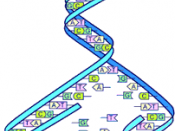The Human Genome Project
The Human Genome Project is a 13-year project started in 1990 and coordinated by the U.S. Department of Energy and the National Institutes of Health. The project originally was planned to last 15 years, but rapid technological advances have accelerated the expected completion date to 2003. Project goals are to
÷identify all the approximate 30,000 genes in human DNA,
÷determine the sequences of the 3 billion chemical base pairs that make up human DNA,
÷store this information in databases,
÷improve tools for data analysis,
÷transfer related technologies to the private sector, and
÷address the ethical, legal, and social issues that may arise from the project.
To help achieve these goals, researchers also are studying the genetic makeup of several nonhuman organisms. These include the common human gut bacterium Escherichia coli, the fruit fly, and the laboratory mouse.
The U.S. Human Genome Project achieved many goals including mapping, sequencing, and identifying genes; storing and analyzing data; and addressing the ethical, legal, and social issues that may arise from availability of personal genetic information.
Some main achievements are the DNA Sequence, of which 99% of gene-containing part of human sequence has been finished to 99.99% accuracy in April 2003. The finished sequence of chromosome 20 in December 2001 comprises almost 60 million base pairs and 99.4% of the euchromatic (genetically active) material. A new approach has been used to compare this single chromosome to sequence data from two other vertebrates -- the puffer fish and the mouse -- and on this count over 95% of all coding exons and almost all the genes have now been analysed.
Finished genome sequences of E. coli, S. cerevisiae, C. elegans, D. melanogaster, plus whole-genome drafts of several others, including C. briggsae, D. pseudoobscura, mouse and rat have been discovered.
Benefits of...


